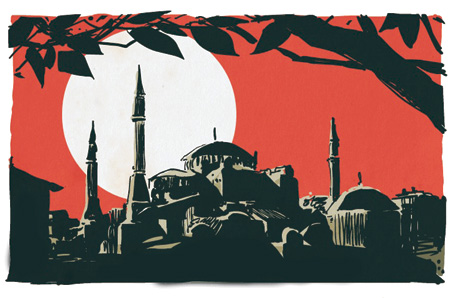Conquest 1453 can only be described, and kindly at that, as a sensationalized and highly distilled depiction of the Ottoman conquest of Constantinople (today’s Istanbul). It portrays the Turkish Sultan Mehmed II as a principled, pious family man and magnanimous ruler. His opponent, Constantine XI Paleologos, the last Byzantine Emperor, comes out as an arrogant, scheming hedonist. No doubt Mehmed II was a brilliant leader and had moments of artful and tolerant statesmanship, but he was no magnanimous family man. Similarly, the historical record shows Constantine as a level-headed, brave leader of his people who died sword in hand; a man who did his level best with few resources and huge dilemmas at hand.
Beyond the two great antagonists, the movie makes any number of glaring historical errors or deliberate omissions. The Byzantine Grand Duke Notaras is placed under a highly civilized arrest after the conquest, and no mention of his beheading, or his insistence that his sons be killed before his eyes to avoid becoming the Sultan‘s sex slaves. Further, the Byzantine nobility is given the Emperor’s body “to be buried in accordance with his faith.“ This is also utterly untrue. Speaking of which, the Sultan then enters Hagia Sophia, the holiest cathedral of Orthodoxy, and declares toleration for all the cowering (though, in the movie, untouched or molested) Christians in the church, even cuddling and kissing a Christian child! This too, is absent from the historical record, though Mehmed did rebuke Turkish soldiers damaging the structure, saying “The treasure and the people are yours, the city and the buildings are mine.“ While Mehmed II did reestablish the Patriarch of Constantinople, setting the anti-Roman Catholic Gennadios on the throne, he can hardly be said to be a magnanimous conqueror.
To be fair, the digitally assisted cinematography of a massive siege, never easy to portray, was generally well done, and the acting was (to this amateur critic) rather good. The film accurately portrayed the divisions between Orthodox Byzantine and Western Christians, which made any Western help halfhearted and caused internal divisions within Byzantine society which the Turks skillfully manipulated. While dramatizing and simplifying certain key events in the siege, the essence was often (though not always) accurate to the historical record.
Also on the positive side, given the absolute lack of any cinematic portrayal of this seismic event in European history, at least someone finally depicted it, albeit in a gratuitously biased and upsetting manner. That no significant Western production exists of such a momentous event is frankly inexplicable. That no large Greek film on this epic struggle exists is almost criminal, and not for the first time the Turks may have “stolen a march” on the historical record, at least on screen. A veil of cinematic silence over the Byzantine Empire’s 1000 year long history has been slightly lifted with this production. Further, despite a generally unfair portrayal of the Byzantines in the film, their position as underdogs “who were there first” comes out, and reminds all that the Byzantines built the city. One particular Turkish critic focused on that point, that it reminded everyone, including the Turks, that Turkey’s greatest city was built by another and taken by the sword.

This is, unfortunately, more than offset on the negative even side by the production’s simplistic portrayal of the Turks as uniformly virtuous and brave and the Byzantines and other Christians as generally scheming and bad. Few Greek or Western historical films, as they use artistic license with historical facts, will any longer portray events in such black and white, frankly simplistic (not to mention wrong) terms. It would be considered bad form. Clearly in Turkey such simplistic and jingoistic cinematography still carries cache. Five million Turks have gone to see it, out of a population of 75 million, and some movie critics received death threats. Many Turks see the movie, and believe it. This is a concern that such a rapidly modernizing country would require perpetuating mythologies, and given the growing power of Turkish media culture, its export to neighboring countries is also of great concern. This will certainly not be the last revisionist blockbuster coming out of Turkey.